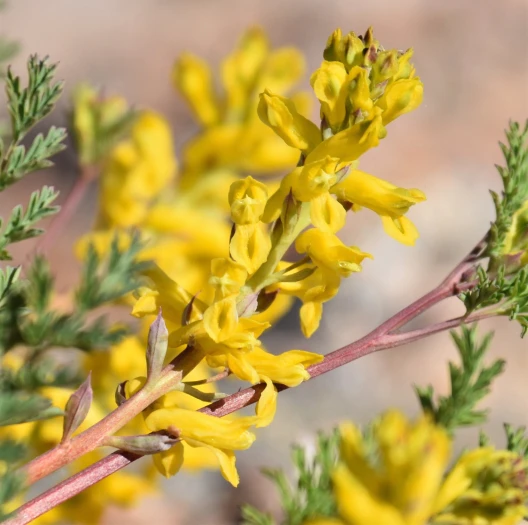Golden Corydalis
(Corydalis aurea)
Golden Corydalis (Corydalis aurea)
/
/

Eric Lamb
CC BY 4.0
Image By:
Eric Lamb
Recorded By:
Copyright:
CC BY 4.0
Copyright Notice:
Photo by: Eric Lamb | License Type: CC BY 4.0 | License URL: http://creativecommons.org/licenses/by/4.0/ | Rights Holder: Eric Lamb | Publisher: iNaturalist | Date Created: 2022-06-04T16:54:51-07:00 |


















Estimated Native Range
Climate Requirements for San Juan Capistrano, California
| This Plant | Your Site | Plant Suitability for Your Location | ||
|---|---|---|---|---|
| • Precipitation | 4" - 70" | 12" | Your precipitation may be insufficient for this plant. Irrigate N" / year. | Irrigate N" / year |
| • High Temp. | 54°F - 109°F | 82°F | Your summer temperatures are normal for this plant. | Excellent |
| • Low Temp. | -27°F - 49°F | 43°F | Your winter temperatures are normal for this plant | Excellent |
This plant should grow well at your location with about N inches per year (Y minutes per month) of irrigation.
Summary
Corydalis aurea, commonly known as Golden Corydalis, is a winter annual herb native to various habitats across North America, including open woodlands, forest edges, and rocky slopes. It is characterized by its blue-green, fern-like foliage and bright yellow, tubular flowers that bloom from April to July, adding a vibrant splash of color to the landscape. The plant typically grows to a height of 10-40 centimeters and produces slender, cylindrical seed capsules after flowering.
Golden Corydalis is valued for its early spring blooms and can be used to add seasonal interest in rock gardens, borders, and naturalized areas. It is relatively low-maintenance, preferring well-drained soils and tolerating a range of conditions from full sun to partial shade. While it is not commonly used for culinary or medicinal purposes, its ornamental appeal lies in its ability to attract pollinators such as bees and butterflies. Gardeners should note that although it is not aggressive, it can self-seed and spread in favorable conditions, which may require management in small garden settings.CC BY-SA 4.0
Golden Corydalis is valued for its early spring blooms and can be used to add seasonal interest in rock gardens, borders, and naturalized areas. It is relatively low-maintenance, preferring well-drained soils and tolerating a range of conditions from full sun to partial shade. While it is not commonly used for culinary or medicinal purposes, its ornamental appeal lies in its ability to attract pollinators such as bees and butterflies. Gardeners should note that although it is not aggressive, it can self-seed and spread in favorable conditions, which may require management in small garden settings.CC BY-SA 4.0
Plant Description
- Plant Type: Herb
- Height: 0.5-2 feet
- Width: 0.5-1 feet
- Growth Rate: Moderate
- Flower Color: Yellow
- Flowering Season: Spring
- Leaf Retention: Deciduous
Growth Requirements
- Sun: Full Sun, Part Shade
- Water: Low, Medium
- Drainage: Fast, Medium, Slow
Common Uses
Border Plant, Butterfly Garden, Low Maintenance
Natural Habitat
Native to various habitats across North America, including open woodlands, forest edges, and rocky slopes
Other Names
Common Names: Scrambled Eggs, Golden Smoke, Pale Corydalis
Scientific Names: Corydalis aurea, Capnodes aureum, Capnoides aureum, Capnoides engelmannii, Capnoides euchlamydea, Capnoides macrorhiza, Capnoides pachyloba, Capnoides pachyloba, Capnoides wetherillii
GBIF Accepted Name: Corydalis aurea